Start
Active lighting
Passive lighting Comparing active & passive visibility in darkness
What about daytime visibility?
Visibility doesn't guarantee safety
|
Passive visibility equipment, and active/passive hybrid versions
Passive lights and equipment only work when all the conditions are right. You will see this demonstrated in the Comparing active & passive visibility in darkness section.
Although passive equipment doesn't always work, it still offers benefits that you should consider. In situations where passive visibility equipment does work, the visual cues from passive visibility equipment help the viewer realize that you are a cyclist, instead of an inexplicable collection of weird lights floating down the road, so they can react appropriately for your safety. Some of these items like reflective vests, legbands and belts can go with you from bike to bike.
|
The limitations of passive equipment
Situations where reflectors, reflective tape or clothing, and other passive items won't work:
The person that you want to see you has no lights. Examples: Pedestrians, equestrians, other cyclists riding ninja. If there is no light coming from them to your reflector, there is nothing for the reflector to reflect back to them.
The person has lights, but they're weak. Examples: motorists with damaged headlights aiming at the ground or the sky. Motorists with one burned-out headlight bulb, particularly the drivers-side bulb. Cyclists with weak lights.
The person has lights, but they're not turned on. Have you seen a motorist pull out of a brightly-lit parking lot at night without realizing his headlights weren't on? This type of thing does happen.
The person has good lights, but they're not aimed at you. Example: a car that's pointing across your path, about to pull out of a side street right in front of you. Its headlights aren't aiming in your direction, so there's no light for your reflectors, etc to reflect back to the car's driver.
Do the math Light intensity drops with the square of the distance that the light travels. If light has to travel from a source to your passive equipment, and then make the return trip back to the source, what does that do to the intensity of the light? Yeah, you see where this is going. An active light produces light at your end, so it only has to travel half the distance. This gets even more important when there's rain, snow or fog absorbing the light as it travels.
You can find more in-depth info about this topic at John Allen's reflector page.
|
|
Reflective and/or self-illuminating reflective legbands I feel that reflective legbands are one of the best passive visibility add-ons for the money, because their cyclic motion attracts the viewer's eye and sends a "human being" signal. They are also low to the ground where low-beam headlights illuminate most strongly, they reflect from a wide range of angles, they can be used with all your bicycles, and they're affordable. Also, there are a couple actively-lighted models from Nathan and Planet Bike available.
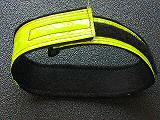  A Jog-A-Lite legband on the left, and a self-illuminating Planet Bike BRT-STRAP (turned off) on the right
A Jog-A-Lite legband on the left, and a self-illuminating Planet Bike BRT-STRAP (turned off) on the right
NiteIze makes more self-illuminating reflective items, if you're interested in this type of equipment.
|
|
Reflective high-visibility vest I've seen lots of commuters endorsing ANSI Class II and Class III vests (typically used by highway workers in the United States), so check local industrial-safety stores for this type of product. I currently use this ANSI Class II vest myself. Compared to a cycling-specific vest, it offers much more reflective tape and the attention-getting neon-lime color.
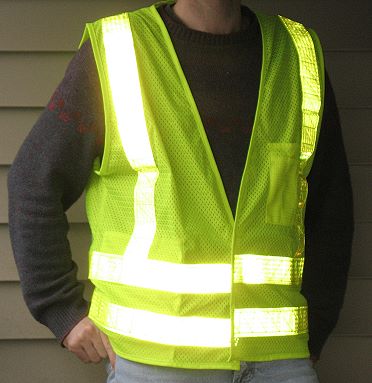 mech's previous ANSI vest, reflecting a bit of camera flash. At first the fit seemed a bit loose, but then I realized the extra room allows it to go over my CamelBak and even a winter jacket.
mech's previous ANSI vest, reflecting a bit of camera flash. At first the fit seemed a bit loose, but then I realized the extra room allows it to go over my CamelBak and even a winter jacket.
|
|
Reflective belt Jog-A-Lite makes a 2-inch-wide/50mm reflective belt. You could also order some reflective tape and make a belt, sash or whatnot of your own, examples at Identi-tape.com
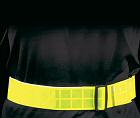 Jog-A-Lite belt
Jog-A-Lite belt
|
|
Reflective tape I put amber TrimBrite reflective tape all over my old commuting bike's frame and fork, and on the rims between the spoke holes. The tape helps the bike show up when lit by headlights from side angles. I think this can help motorists "acquire" me as a cyclist more easily in darkness, due to the size and shape cues.
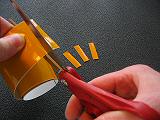 
Later I found that there's tape that performs even better, generically categorized as "High-Intensity" tape. One good online source of it in the United States is Identi-tape.com. You can also find it in auto-parts stores, ask for DOT Conspicuity Tape or the equivalent (it typically has a diamond pattern). The photo below shows my fenders with High-Intensity reflective tape, as well as my DOT automotive-type reflectors (see below). Try to keep your reflective tape clean so it reflects well.
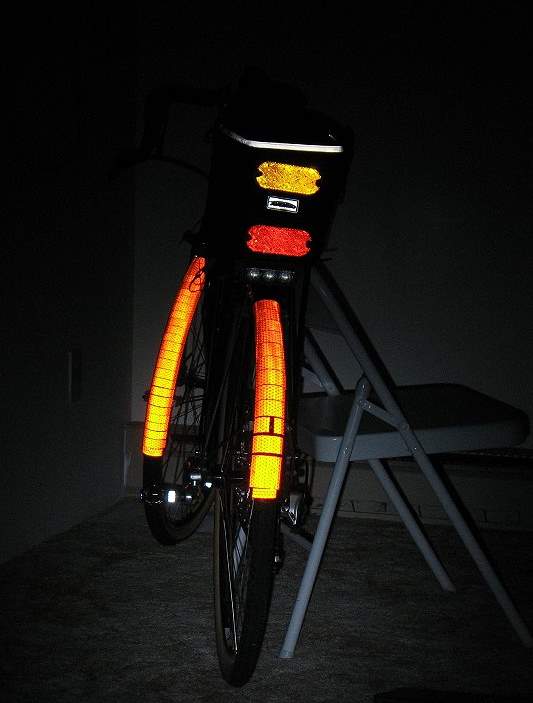
A further comment about reflective tape compared to plastic cube-corner reflectors: reflective tape can reflect light back to its source even when the light is hitting the tape at pretty severe angles of approach. Plastic cube-corner reflectors (like the ones shown in the three pictures below) do not handle that scenario well. If you're debating whether to use reflective tape in addition to plastic reflectors, keep this in mind.
|
|
Wide-angle bicycle reflectors Even if the laws in your area don't require a rear reflector, you can add them as baseline last-ditch safety equipment. If you use conventional pedals, then consider amber pedal reflectors on the front and rear of the pedal cages, which also may be required by law.
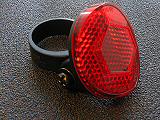 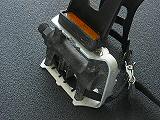
|
|
Automotive-type reflectors This type of reflector isn't wide-angle. It is intended to reflect light that's coming at it squarely from the rear. This is a superior reflector design where the viewer is at long range, almost directly to the rear, such as out on the highway, because the reflector is much larger than a typical bicycle wide-angle reflector. Also, the entire surface is devoted to direct-rear reflection. If you have the room and don't mind the appearance, you might stitch one to the rear of each pannier or find some other way to attach them. I seared holes in my rack-top bag, and used Zip ties to attach a pair of these reflectors to the rear of it.
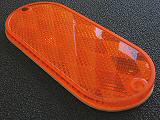 The foam-backed version shown here is very lightweight
The foam-backed version shown here is very lightweight
|
|
White, lime-green, or yellow clothing I did some videotaping of myself in front of my car with its low-beam headlights on, and my neon-yellow jacket is not much help except at extremely close range. However, being visible at extremely close range is still useful. It may help your arm signals be visible to others in traffic, and it may help motorists identify you as a cyclist at intersections. Consider wearing a neon-yellow or white jacket or long-sleeved jersey if temperatures are low enough to need arm coverage. If you're down to just a short-sleeved jersey, then consider wearing a light-colored reflective vest over a light-colored jersey. Lime-green is more visible in darkness than orange, if you're planning to buy an ANSI safety vest and can't decide which color you want.
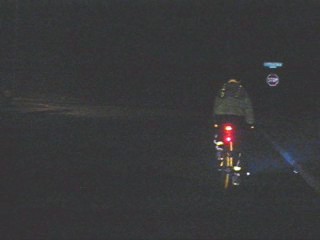
click to enlarge
|
|
Tires with reflective sidewalls
Continental, Schwalbe and Vittoria are some companies offering tires with reflective sidewall stripes. Thanks to Bekologist for reminding me about this type of passive visibility equipment and getting me a picture. : )
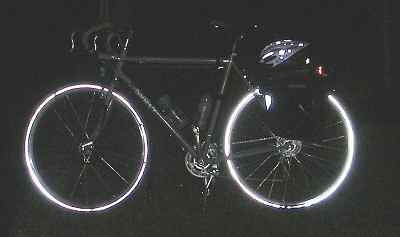
|
|
|
Next: Comparing active & passive visibility in darkness
|
 ©
©
 ©
©